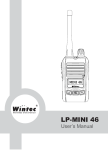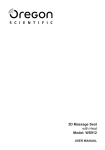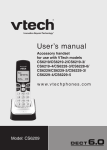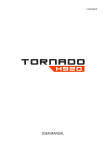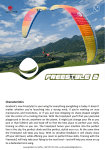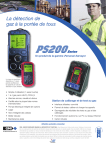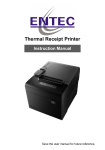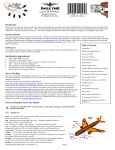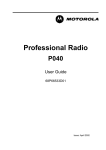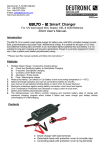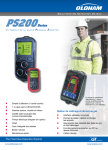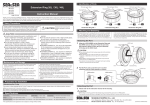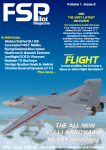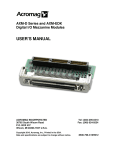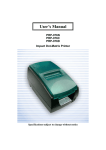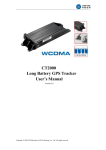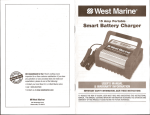Download Product Introduction
Transcript
Table of Contents Product Introduction The Su-34 is the first foam jet model that uses vectored thrust control. Through controlling the direction of the thrust nozzle, you will be able to imitate all kinds of thrilling maneuvers that are possible in the Full-Scale Russian aircraft. Product Introduction..................................................2 Before Beginning Assembly......................................2 Parts Included in Kit (receiver ready version)............2 Main Specifications (receiver ready version).............3 Read Before Flight (general safety guidelines) ........3 Safety Instructions for Charging and Using Li-Poly Batteries ..........................................3 Safety Precautions....................................................3 General Safety Statements.......................................3 Battery Precautions...................................................4 Mixing Epoxy.............................................................4 Wing Install................................................................5 Stabilizer and Rudder Install.....................................5 Front Winglet Install...................................................6 Defensive Radar Pod Install......................................7 Nose Cone Install......................................................7 Missile Install.............................................................8 Linkage Install...........................................................9 Programming Your Radio..........................................10 Checking the Mixing..................................................11 Retract Adjustment....................................................12 70mm Fan Install.......................................................12 Flying the Su-34 Fullback..........................................13 Center of Gravity.......................................................13 Replacement Parts....................................................14 Before Beginning Assembly This model is designed for assembly and operation by experienced modelers. Make sure you read through the illustrated instructions before beginning the assembly process. Please contact Hobby Lobby if you have any questions regarding the assembly or operation of your model, to discuss any potential problem areas of assembly, or the possibility of returning the unassembled model if you feel you cannot complete it as described in this manual. Parts Included in Kit (receiver ready version) • • • • • • • • Fuselage (pre-painted and decorated) • Rudders • 64mm Ducted fans (pre-installed) (2pcs) • Vectored Thrust nozzles (pre-installed) (2pcs) • Two-part 5-minute epoxy • Canopy • Outrunner Brushless motors (pre-installed) (2pcs) Retractable landing gear set with steerable nosewheel 2 Main wing set (pre-painted and decorated) Elevators Brushless ESC’s 45A (pre-installed) (2pcs) Decals (pre-applied) 4-Cell Li-poly Battery 25C Instructions Main Specifications (receiver ready version) Safety Precautions Wingspan: 35-1/2" [900mm] Length: 57" [1450mm] Weight: 52.91oz [1500g] Thrust: 52.91–56.43oz [1500–1600g] Thrust to Weight: 1:1 Motor System:3500Kv out runner brushless motor (2pcs) Speed Control: 45A ESC (2pcs) Battery:4-Cell 14.8V 3000mah 25C Li-poly battery Servos: 9g, (10pcs) 1. Please do not change any part of the plane without checking with Hobby Lobby. You will be responsible for any damages caused by these changes. 2. Your flying area should be wide-open and free of obstacles. Never fly near highways, railways, airports, power lines or in residential areas. 3. To avoid personal injury, never fly your model near or facing people, or throw the plane in their direction. 4. Do not fly your model in strong winds or severe weather. 5. Do not allow loose objects, tools or body parts to get near the intake of your model. Items can be pulled in and can damage the model or cause personal injury. 6. Never dispose of batteries or parts of your model in a fire as it could lead to an explosion and personal injury. Read Before Flight (general safety guidelines) 1. Before each flight, please check the aircraft using the radio system. Check the operation of all control surfaces and the motors to make sure they are operating properly and that none of the clevises or connectors are damaged. 2. This aircraft is not a toy! Its operation is quite different from RC cars and RC boats. Before flying, please read the user manual carefully and obey the regulation in order to enjoy a safe and pleasant flight. 3. Before flying your model, make sure there are no other pilots using the same frequency within 1.2 miles of your model if flying using a 72MHz radio system. Please refrain from flying until you have discussed who flies when so your plane does not become damaged from stray radio signals. 4. If you find any parts included with this model that are defective, contact Hobby Lobby before starting assembly. General Safety Statements 1. This aircraft is not a toy. It has been designed for the experienced modeler and pilot. You are responsible not to cause damage to other’s personal property or cause personal injury. 2. Please follow the instructions provided to build, adjust and operate your model. Use caution not to get hands, hair or other body parts near the fans. Doing so could cause personal injury. 3. Hobby Lobby and our dealers are not responsible for any economic or law liability for any improper usage or operation of this model. 4. This model is designed for use by modelers age 14 and over. This model is not recommended for unsupervised modelers under 16 years of age. 5. Never use the model or associated electronics in damp or rainy conditions. 6. This model is made from EPS and Polystyrene, which can be damaged by excessive heat. Keep you model away from excessive heat or out of direct sunlight for extended time periods or it can become warped and affect the flight performance of the model. 7. Never attempt to catch your model while in flight. 8. Never leave the battery connected while the model is unattended. Accidental operation can occur and cause personal injury. 9. Before operating the model, make sure to turn on the radio system and check the functions before beginning flight. 10. Always make sure the throttle at the transmitter has been moved to the low or off position before connecting the motor battery. Safety Instructions for Charging and Using Li-Poly Batteries • • • • • • • • • Do not put the battery on, or near anything, that can catch fire when charging. Always charge the battery on a non-flammable base i.e. a metal tray. Do not disassemble the battery. Do not short-circuit the battery. Do not use, or leave, the battery nearby a fire, stove or heated place. Do not immerse the battery in water or seawater, do not get it wet. Do not charge the battery near a fire or under the blazing sunlight. Do not drive a nail into the battery, strike it with hammer or apply excessive weight to the battery. Do not impact or throw the battery. 3 Battery Precautions • • • • • • • • • • • • • • • • • • • • • • Mixing Epoxy Do not use the battery if it is damaged or deformed. Do not solder the motor leads directly to the battery. Do not reverse charge or over discharge the battery. Do not reverse charge or connect the battery in reverse to the speed control. Do not connect the battery to the ordinary charger socket or car cigarette jack. Do not use the battery for unspecified equipment. Do not touch the leaking battery directly. Wash your skin or clothes with water if they come in contact with a damaged battery. Do not mix the Li-Po battery with other unchargeable battery. Do not continue charging the battery over the prescribed time. Do not put the battery into a microwave oven or high-pressure container. Do not use an abnormal or damaged battery. Do not use or store a battery under the sunlight. Do not use the battery near any sources that generate static electricity (over 64V) Do not charge the battery when the environmental temperature is under 32 degrees or over 130 degrees. If you find the battery leaking smelling or abnormal, stop using it. Keep the battery away from children. Use the specified charger and observe charging requirement provided by the battery manufacturer. Parental supervision is required when charging or operation is done by minors. Never charge the battery at a rate greater than specified by the battery manufacturer. Never discharge the battery at more than 25C and never take the voltage lower than 12V as this will damage the battery. For full flight time it is recommended to cycle the battery a minimum of three cycles before use in your model. Never charge the battery on a carpet floor as this can cause a fire. When mixing epoxy, make sure to use equal amounts of Part A and Part B. Mix the epoxy thoroughly. You will have about 3 minutes before the epoxy begins to cure after mixing so work quickly. Do not mix epoxy until you fully understand the assembly procedure. 4 Wing Install Attach the wing panels one at a time. Make sure each panel is tight to the side of the fuselage and the upper surface of the wing is flush with the adjoining fuselage surface. Read through the following steps before attaching the wings to the fuselage. You will need to complete these steps before the epoxy begins to cure. Mix some epoxy to glue the wings to the fuselage. Apply a thin layer of epoxy to the wing root and fuselage to glue the wings to the fuselage. Stabilizer and Rudder Install Apply Epoxy Gluing the stabilizers and rudders follows the same procedure as gluing the wings. Make sure to align each part equally on each side of the fuselage. Plug the aileron servo into the lead coming from the fuselage. Press the wing tightly against the fuselage. 5 Front Winglet Install Gluing the front winglets is the same as all the previous items installed. Make sure to align each part equally on each side of the fuselage. 6 Defensive Radar Pod Install Nose Cone Install Gluing the defensive radar pod follows the same procedure as gluing the wings. Make sure it is aligned with the center line of the fuselage vertically and horizontally. Use epoxy to glue the nose cone to the fuselage. Make sure the nose cone fits tight on the fuselage. 7 Missile Install The large and small missiles are attached to the wing using epoxy. A small amount of epoxy is all that is required to glue them to the wing. Mix a small amount of epoxy and apply it to the notch in the large missile. Mix a small amount of epoxy and apply it to the small missile. The small missile it is attached directly to the wing as shown. Insert the missile bracket in the slot. Make sure the wide notch faces the front of the missile. Narrow Wide Apply epoxy to the missile bracket. The bracket is then attached to the wing. 8 Linkage Install Plug the leads for the servos into your receiver. Each lead is marked to the correct position on the receiver. Before installing the linkages to the control surfaces and vectored nozzles you will need to center the servos. Use the sub-trim feature of your radio system to center each servo. Each vectored thrust nozzle has a reference line so it can be centered. Connect the linkage and check this reference line. If it does not align, adjust the clevis until it does. Connect the linkages to the stabilizers and ailerons. Adjust the clevises so the control surfaces are aligned with the fixed surfaces. 9 Programming Your Radio Under Programmable Mixing 1, set ELEV to mix to AUX2. The settings are shown in the photo below. This is mixing the Elevator to the Left Vectored Thrust Nozzle. We have included instructions to program a SpektrumTM DX7 radio. Following these instructions will provide both elevator and aileron vectored thrust for your Su-34 Fullback. Different radios may require different settings than shown. Set the following functions under the Input Select screen. Set switch to "MIX" to Activate/Deactivate Elevator Vectored Thrust mixing.Under Programmable Mixing 2, set ELEV to mix to FLAP. The settings are shown in the photo below. This is mixing the elevator to the Right Vectored Thrust Nozzle. Make sure to set the Flaperon, V-Tail and Delta to OFF. Under Programmable Mixing 3, set AILE to mix to AUX2. The settings are shown in the photo below. This is mixing the Aileron to the Left Vectored Thrust Nozzle. You will also need to set the servo reversing to match the settings shown in the photo for all the surfaces to move in the correct directions. 10 Checking the Mixing Under Programmable Mixing 4, set AILE to mix to FLAP. The settings are shown in the photo below. This is mixing the Aileron to the Right Vectored Thrust Nozzle. Use the following diagrams to check the mixing of the control surfaces in relationship to the vectored thrust. Elevator Operation When the "MIX" switch is activated, the vectored thrust nozzles will move in unison with the elevators. When the elevators are centered, the vectored thrust nozzles will be centered. Set switch to "FLAP 2" to Activate/Deactivate Aileron Vectored Thrust mixing. To provide smooth flying, you will want to adjust the radio for the following Dual Rate and Exponential settings. This will make your Su-34 Fullback easier to fly. When down elevator is given, the vectored thrust nozzles will move downward. When up elevator is given, the vectored thrust nozzles will move upward. When the "MIX" switch is Deactivated the elevators will function normally but the vectored thrust nozzles will not move. NOTE: Vectored thrust to Elevator mixing should be deactivated during take off and landing of the model. 11 Retract Adjustment When the "FLAP 2" switch is activated the vectored thrust nozzles will move in unison with the ailerons. When the ailerons are centered, the vectored thrust nozzles will be centered. The retracts are fully installed when you receive the model and should not require adjustment. If you find the servos are binding at either end of travel, it may be necessary to adjust the end points in the radio programming. 70mm Fan Install To replace the stock fan, or to install a 70mm fan, carefully cut along the line shown in the photo. This line is the seam between the fuselage and cover. When right aileron is given, the left vectored thrust nozzle will move downward and the right vectored thrust nozzle will move upward. Align the 70mm fan with the concave area in the fuselage. Note the direction of the fan in the photo. When left aileron is given, the left vectored thrust nozzle will move upward and the right vectored thrust nozzle will move downward. If you find that the surfaces and vectored thrust nozzles do not move in unison as shown, you will need to check the programming in the radio. 12 Flying the Su-34 Fullback The Su-34 has solid flight character, when flown as a conventional electric ducted fan model (without using the vectored thrust) the jet exhibits very stable and predictable flight performance. The two 64mm fans produce nearly a 1 to 1 thrust to weight ratio due to their pairing with the 3500KV outrunner motors and the 4-cell 3000mAh battery. The flying speed is broad allowing slow landings or high speed passes. When the vectored thrust nozzles are active, wild performance begins. Maneuvers that are simply not possible with conventional jets are easily performed. The famous “Cobra Maneuver” is a sharp vertical climb from level flight and then a sharp push over back to level flight. Variations; like a vertical zoom to an impossibly tight back flip or forward flip are possible. The thrust vectoring gives you a lot of control even at speeds that are too slow for conventional jets to perform. The retractable landing gear is best suited to smooth runways. If flying from taller grass, hand launching is easily accomplished. There are a couple of techniques that are helpful to learn with the Su-34. Landing on a runway is best accomplished with the vectored thrust mixing turned off. Make a normal approach holding just a little power and the nose raised, arresting your decent just before touchdown with the addition of a additional power. When this is done with the thrust vectoring OFF a soft touchdown is easy. If you leave the thrust vectoring ON you increase your chance of “ballooning” when you add power and possibly landing harder than you anticipated. Flight times are approximately 4 minutes and timing your flights is recommended. When belly landing the model in taller grass it is best to keep the thrust vectoring turned ON for the landing. This allows you to really slow the model by holding the nose up in a “Harrier” type approach and actually touching down with very little forward speed. The Su-34 turns heads whenever it shows up at the flying field, we hope that you enjoy yours as much as we do. Center of Gravity If you use our recommended equipment you will not need to adjust the balance of your model. If your equipment does not match our suggestions, or you change the airframe, you will need to balance your model. The balance point of the Su-34 Fullback is as shown in the drawing. CG: 3-13/16" [96mm] 13 Replacement Parts Ducted Fan Set - FWF90210 Main Wing Set - FWF900103 Vectored Thrush Nozzle Set - FWF900111 Tail Wing Set - FWF900102 Retract Set - FWF900106 Guided Missiles - FWF900110 Decal Set - FWF900107 Canopy - FWF900109 14 Fuselage Set - FWF900104 Brushless Power System - FW3070 40-Amp Speed Control - FWF550504 3000mAh 4-Cell Li-Poly Battery - FW3026 Brushless Motor - FWF90137 15 Have Fun! We hope that you have many pleasant flights with your Sukhoi Su-34 Fullback. Hobby Lobby International 5614 Franklin Pike Circle Brentwood, TN 37027 www.hobby-lobby.com 0001


















